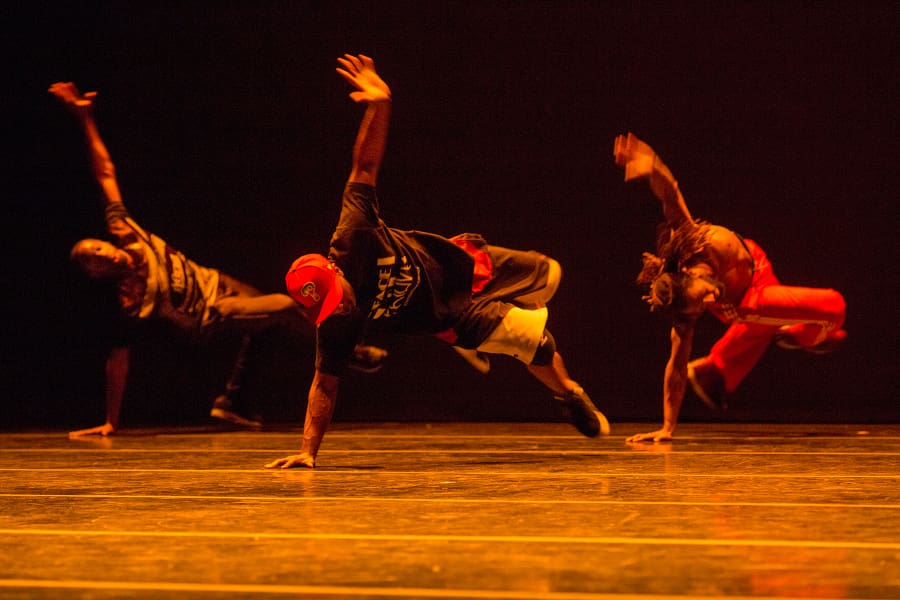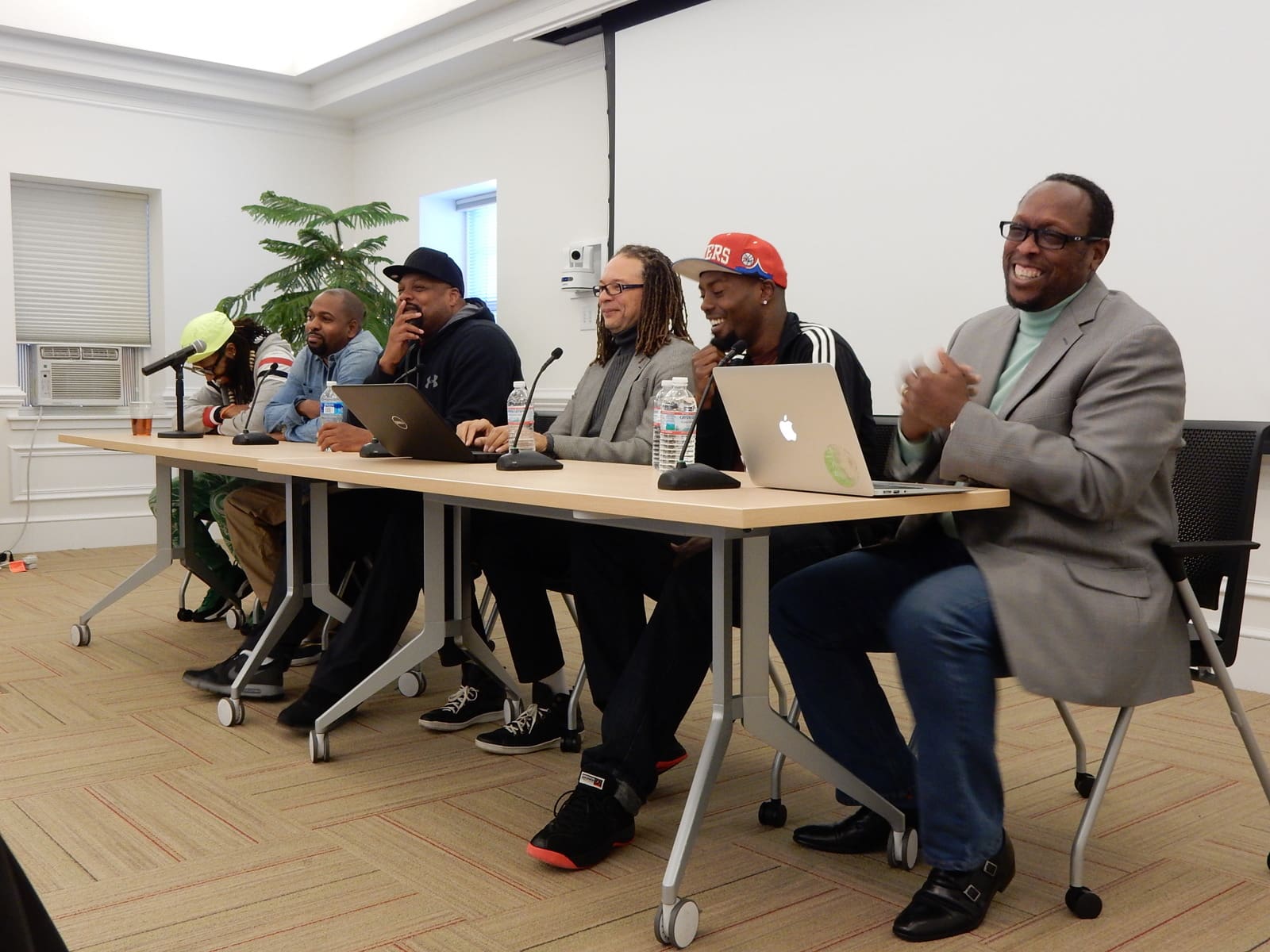
Dr. Lorenzo “Rennie” Harris has come a long way since he and his fellow Cobra III members danced their way to a win at a North Philadelphia church talent show when they were 12 or 13. By high school he had learned how to “step” and had begun his lifetime of dancing, which took him on to New York breakdance contests, to the first hip hop tour to cross the country, to his current status as a world-renowned choreographer, historian, mentor and ambassador of hip hop.
Along the way he founded Rennie Harris Puremovement (RHPM) in 1992, convinced that hip hop was the most important original expression of a new generation—a contemporary indigenous art form. He is now a respected voice on the history of hip hop, able to explain the roots of a culture that has become an international movement and developing his company to be effective educators.
Duke was privileged to host Rennie Harris Puremovement for a residency in October, thanks to Duke Performances. As Aaron Greenwald, executive director of Duke Performances, told the Duke Chronicle, “Hip hop has proven its staying power, its international influence, its capacity to articulate social and cultural concerns, its ability to innovate aesthetically.”

So Duke Performances launched a Hip-Hop Initiative last fall to run two years, focused on engaging the Duke and Durham community and lining up a series of internationally acclaimed artists for weeklong residencies. Besides Rennie Harris, they presented Chilean rapper Ana Tijoux in a sold-out show at Motorco Music Hall in October 2015 and Ghanaian rapper Blitz the Ambassador in February 2016.
While in residence, Harris—who normally no longer travels with the company—and the dancers offered master classes, lectures, demonstrations, workshops, and Q&A sessions with classes at Duke, at two public schools in Durham and with dance clubs from both on campus and off.
Harris and several RHPM members joined Duke dance professor Thomas F. DeFrantz at the John Hope Franklin Center for a public conversation about the history and influence of hip-hop dance and culture. The event, entitled “#BlackMovementMatters: Dance, Hip-Hop, and Social Justice,” was moderated by Mark Anthony Neal (see the video). The week culminated with two public performances at Reynolds Industries Theater.

More than a thousand people engaged with Puremovement throughout the week, but facts and stats tell only part of the story.
“We had a really superb session with Rennie Harris,” says Barbara Dickinson, professor in the Duke Dance Program. “I had the students do research on the company and they came up with questions that most intrigued them. Harris was very articulate and thoughtful—he has lived the history of hip hop so he understands it, and the conversation got many layers deep.”
Some of Dickinson’s female students were interested in the fact that Puremovement is made up of women and men in a traditionally machismo art form. Harris explained that he likes to challenge those who see hip hop as a purely male form of expression. He also likes to provide audiences with a view of the essence and spirit of hip hop rather than the commercially exploited stereotypes portrayed by the media.
Dance professor Andrea Woods Valdés was delighted by the master class RHPM taught to her advanced modern dance students. “Students in the dance program have diverse interests and experiences and, in a nutshell, they ate it up. Each segment of the non-stop, action-packed class was taught by a different company member and reflected a different style. The message in the class as well as in the company’s performance was that hip hop has a complex and varied history, and as dancers, scholars and audience members, we were being exposed to and were participating in its rich cultural history.”
Rennie Harris Puremovement annex class 2
Warm-up is over… it’s time to hit the floor!
Posted by Duke University Dance Program on Tuesday, October 20, 2015
Professor DeFrantz looks back on the RHPM’s visit to his class with just as much enthusiasm. “As the students and the artists met and mingled, Harris shared stories about his career and his ambitions as an artist. Students and RHPM members alike asked and answered questions about embodied practices and the reach of hip hop around the world. At the end of the session, we danced together, and this ten minutes was lively, smart, dynamic and entirely thrilling for all of us.”
Members of RHPM also visited two Durham schools, Hillside High and Riverside High. Nicole Oxendine, the dance teacher at Hillside says, “It was a really great experience—the Q&A was especially good. Students were interested in what it takes to be in a troupe. They loved having the pros in their space.”
Riverside High dance teacher Kristin Taylor was thrilled that her students got to meet and speak with professional dancers. “The biggest thing for me is continually trying to get exposure to professional dance for my students, so this fit my goal perfectly. It is great that Duke offers this.”
An active interplay of performer and audience, rooted in the African American tradition of call and response, is an essential part of the hip-hop tradition. In his talks at Duke, Rennie Harris noted that this can be a challenge to audiences who are used to sitting though performances in silence. Early in his career, when hip hop was first expanding from the streets to the stage, he found that it was best to explain the street tradition to audiences so they knew how they fit in.
From the way dance student Emily Crossman describes the show, it’s clear that the audience at Duke rose to the occasion. The performance began with a social “jam circle,” in which “dancers locked, dropped, twisted, spun, and flipped right through the circle; it drew the audience in from the very beginning. It was incredible to see the performers feed off of the energy and cheers of encouragement that rose from the audience.
“The special bond that was created in the first piece invited the audience to invest themselves emotionally and energetically in the entire performance,” she says.
Student Yi Ying The felt that her experience of the performance was enriched by the visit Harris made to her class. “It was wonderful meeting him in person before watching the company perform—it added so much depth to the performance and enabled me to view the work more critically.
“This was easily one of my favorite class sessions the entire semester, and I hope that Duke Performances continues to bring in performers,” she adds. “I have benefitted greatly from the residencies, from taking classes with Ronald K Brown in an earlier residency to grappling with dance concepts intellectually and historically with Rennie Harris.”
Successful residencies are a win-win, because the artists appreciate the opportunity Duke Performances offers too.
In a post-residency note, RHPM company manager Rodney Hill wrote, “thanks for a successful week of residency last week. This could not happen without the Duke Performances team….The RHPM company dancers are still talking about the fun week they all had in Durham…. I would like to end this email just to say thank you, thank you for believing in what Rennie Harris does as an Artist!”